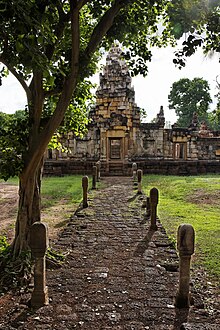
Back Sdok Kok Thom Afrikaans Prasat Sdok Kok Thom French Sdok Kok Thom Italian ប្រាសាទស្ដុកកក់ធំ Cambodian Сдоккактхом Russian อุทยานประวัติศาสตร์สด๊กก๊อกธม Thai Сдок Кок Тһом Tatar Сдоккактхом Ukrainian Sdok Kak Thom Vietnamese
| Sdok Kok Thom | |
|---|---|
 | |
| Religion | |
| Affiliation | Hinduism |
| Province | Sa Kaeo |
| Deity | Śiva |
| Location | |
| Location | Ban Nong Ya Kaeo Mu 9, Tambon Khok Sung, Amphoe Khok Sung |
| Country | Thailand |
| Geographic coordinates | 13°50′37.29″N 102°44′14.84″E / 13.8436917°N 102.7374556°E |
| Architecture | |
| Type | Khmer |
| Creator | Udayādityavarman II |
| Completed | 11th century |
Sdok Kok Thom (Thai: สด๊กก๊อกธม, Sadok Kok Thom, pronounced [sādók kɔ́k tʰōm]; Khmer: ស្តុកកក់ធំ, Sdŏk Kák Thum [sɗok kɑk tʰum]), or Sdok Kak Thom, is an 11th-century Angkorian temple in present-day Thailand, located about 34 kilometres (21 mi) northeast of the Thai border town of Aranyaprathet. The temple is in Khok Sung District, Sa Kaeo Province, near the village of Ban Nong Samet. It is regarded as the largest Angkorian temple in eastern Thailand.[1] The temple was dedicated to the Hindu god Shiva. Constructed by a prominent priestly family, Sdok Kok Thom is the original site of one of the most illuminating inscriptions left behind by the Khmer Empire, which ruled much of Southeast Asia from the end of the 9th century to the 15th century.
Built of red sandstone and laterite, the temple is a prime example of a provincial seat of worship during the empire's golden age. It is small by the standards of the major monuments in Angkor, the empire's capital, but shares their basic design and religious symbolism. In its 11th century heyday during the reign of King Udayādityavarman II, the temple was tended by its Brahmin patrons and supported with food and labor by the people of surrounding rice-farming villages.
Scholars disagree as to the meaning of the name, which refers in Old Khmer to the temple's setting. Translations include 'great reed lake', 'large reservoir with herons', and 'abundant reeds in a large swamp'.
- ^ ""สด๊กก๊อกธม" ปราสาทหินแห่งสระแก้ว ใหญ่สุดในภาคตะวันออก" ["Sdok Kok Thom" Rock castle of Sa Kaeo largest in the eastern region]. ASTV Manager (in Thai). 2018-05-31.
